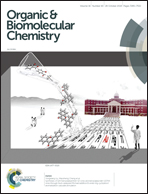H- and J-aggregates formed from a nontraditional π-gelator depending on the solvent polarity for the detection of amine vapors†
Abstract
A tert-butyl carbazole-modified difluoroboron β-diketonate complex (TCbzB) has been synthesized. Although no traditional gelation group was involved in TCbzB, it could form organogels in the mixed solvents of o-dichlorobenzene/cyclohexane (v/v = 1/5 or 1/2), toluene/cyclohexane (v/v = 1/2) and chlorobenzene/cyclohexane (v/v = 1/2). Interestingly, an orange organogel was obtained in o-dichlorobenzene/cyclohexane (v/v = 1/2) with relatively high polarity and red organogels were gained in the other three mixed solvents with relatively low polarity. TCbzB self-assembled into H-aggregates and J-aggregates in orange and red organogels, respectively, and the corresponding xerogels emitted yellow and red light, respectively, under UV illumination. The red emission of the xerogel-based film could be quenched significantly by gaseous n-propylamine and aniline because of the decomplexation of the difluoroboron β-diketonate complex by n-propylamine and the weak interactions between aniline and boron difluoride units.



 Please wait while we load your content...
Please wait while we load your content...